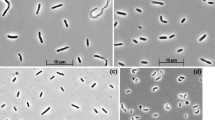Abstract
Strictly anaerobic bacteria were enriched and isolated from freshwater sediment sources in the presence and absence of sulfate with sorbic acid as sole source of carbon and energy. Strain WoSo1, a Gram-negative vibrioid sulfate-reducing bacterium which was assigned to the species Desulfoarculus (formerly Desulfovibrio) baarsii oxidized sorbic acid completely to CO2 with concomitant stoichiometric reduction of sulfate to sulfide. This strain also oxidized a wide variety of fatty acids and other organic compounds. A Gram-negative rod-shaped fermenting bacterium, strain AmSo1, fermented sorbic acid stoichiometrically to about equal amounts of acetate and butyrate. At concentrations higher than 10 mM, sorbic acid fermentation led to the production of pentanone-2 and isopentanone-2 (3-methyl-2-butanone) as byproducts. Strain AmSo1 fermented also crotonate and 3-hydroxybutyrate to acetate and butyrate, and hexoses to acetate, ethanol, hydrogen, and formate. The guanine-plus-cytosine content of the DNA was 41.8±1.0 mol%. Sorbic acid at concentrations higher than 5 mM inhibited growth of this strain while strain WoSo1 tolerated sorbic acid up to 10 mM concentration.
Similar content being viewed by others
References
Bayer H & Walter W (1988) Lehrbuch der organischen Chemie, 21 ed. Hirzel Verlag, Stuttgart
Beaty PS & McInerney MJ (1990) Nutritional features of Syntrophomonas wolfei. Appl. Environ. Microbiol. 56: 3223–3224
Borst-Pauwels GWFH & Jager S (1969) Inhibition of phosphate and arsenate uptake in yeast by monoiodoacetate, fluoride, 2,4-dinitrophenol and acetate. Biochim. Biophys. Acta 172: 399–406
Bradford M (1976) A rapid and sensitive method for the quantification of microgram quantities of protein utilizing the principle of protein-dye binding. Anal. Biochem. 72: 248–254
Brandis-Heep A, Gebhardt NA, Thauer RK, Widdel F, Pfennig N (1983) Anaerobic acetate oxidation to CO2 by Desulfobacter postgatei. 1. Demonstration of all enzymes required for the operation of the citric acid cycle. Arch. Microbiol. 136: 222–229
De Ley J (1970) Reexamination of the association between melting point, buoyant density and the chemical base composition of deoxyribonucleic acid. J. Bacteriol. 101: 738–754
Diekert GB & Thauer RK (1978) Carbon monoxide oxidation by Clostridium thermoaceticum and Clostridium formicoacetium. J. Bacteriol. 136: 597–606
Eklund T (1985) The effect of sorbic acid and esters of p-hydroxybenzoic acid on the protonmotive force in Escherichia coli membrane vesicles. J. Gen. Microbiol. 131: 73–76
Fulgraff G (1989) Lebensmitteltoxikologie, 1 ed. Ulmer Verlag, Stuttgart
Freese E, Sheu CW & Galliers E (1973) Function of lipophilic acids as antimicrobial food additives. Nature 241: 321–325
Janssen PH & Harfoot CG (1990) Ilyobacter delafieldii sp. nov., a metabolically restricted anaerobic bacterium fermenting PHB. Arch. Microbiol. 154: 253–259
Magee CM, Rodeheaver G, Edgerton MT & Edlich RF (1975) A more reliable Gram staining technic for diagnosis of surgical infections. Am. J. Surgery 130: 341–346
Marmur J (1961) A procedure for the isolation of deoxyribonucleic acid from microorganisms. J. Mol. Biol. 3: 208–218
Matthies C & Schink B (1991) Reciprocal isomerization of butyrate and isobutyrate through a coenzyme B12-dependent butyryl-CoA: isobutyrylCoA mutase in cell-free extracts of strain WoG13. Arch. Microbiol. (submitted)
Pfennig N (1978) Rhodocyclus purpureus gen. nov. and sp. nov., a ring-shaped, vitamin B12-requiring member of the family Rhodospirillaceae. Int. J. System Bacteriol. 23: 283–288
Ronning IE & Frank HA (1987) Growth inhibition of putrefactive anaerobe 3679 caused by stringent-type response induced by protonophoric activity of sorbic acid. Appl. Environ. Microbiol. 53: 1020–1027
Ronning IE (1989) Morphological changes in putrefactive anaerobe 3679 (Clostridium sporogenes) induced by sorbate, hydrochloric acid and nitrite. Can. J. Microbiol. 35: 388–398
Russel AD & Gould GW (1988) Resistence of Enterobacteriaceae to preservatives and disinfectants. J. Appl. Bacteriol. Symp. Suppl: 167S–195S
Salmond CV, Knoll RG & Booth JR (1984) The effect of food preservatives on the pH homeostatis in Escherichia coli. J. Gen. Microbiol. 130: 2845–2850
Schauder R, Eikmanns B, Thauer RK, Widdel F & Fuchs G (1986) Acetate oxidation to CO2 in anaerobic bacteria via a novel pathway not involving reactions of the citric acid cycle. Arch. Microbiol. 145: 162–172
Schink B & Pfennig N (1982) Fermentation of trihydroxybenzenes by Pelobacter acidigallici gen. nov. sp. nov., a new strictly anaerobic, non-sporeforming bacterium. Arch. Microbiol. 133: 195–201
Schnell S & Schink B (1991) Anaerobic aniline degradation via reductive deamination of 4-aminobenzoyl-CoA in Desulfobacterium anilini. Arch. Microbiol. 155: 183–190
Stieb M & Schink B (1984) A new 3-hydroxybutyrate fermenting anaerobe, Ilyobacter polytropus gen. nov. sp. nov., possessing various fermentation pathways. Arch. Microbiol. 140: 139–146
Tholozan J-L, Samain E & J-P Grivet (1988) Isomerization between n-butyrate and isobutyrate in enrichment cultures. FEMS Microbiol. Ecol. 53: 187–191
Widdel F (1988) Microbiology and ecology of sulfate- and sulfur-reducing bacteria. In: Zehnder AJB (Ed) Biology of Anaerobic Microorganisms (pp 469–639). Wiley & Sons, New York
Widdel F & Bak F (1991) Gram-negative mesophilic sulfate-reducing bacteria. In: Balows A, Trüper HG, Dworkin M, Harder W & Schleifer KH (Eds) The Prokaryotes, 2nd edition. Springer New York (in press)
Widdel F & Pfennig N (1981) Studies on dissimilatory sulfate-reducing bacteria that decompose fatty acids. I. Isolation of new sulfate-reducing bacteria enriched with acetate from saline environments. Description of Desulfobacter postgatei gen. nov. sp. nov. Arch. Microbiol. 134: 286–294
Widdel F, Kohring GW & Mayer F (1983) Studies on dissimilatory sulfate-reducing bacteria that decompose fatty acids. III. Characterization of the filamentous gliding Desulfonema limicola gen. nov. sp. nov., and Desulfonema magnum sp. nov. Arch. Microbiol. 134: 286–294
Author information
Authors and Affiliations
Rights and permissions
About this article
Cite this article
Schnell, S., Wondrak, C., Wahl, G. et al. Anaerobic degradation of sorbic acid by sulfate-reducing and fermenting bacteria: pentanone-2 and isopentanone-2 as byproducts. Biodegradation 2, 33–41 (1991). https://doi.org/10.1007/BF00122423
Received:
Accepted:
Issue Date:
DOI: https://doi.org/10.1007/BF00122423




